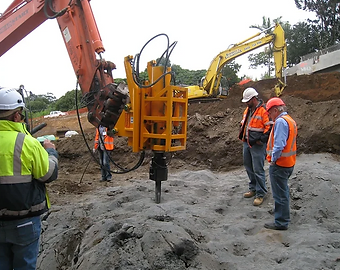Revolutionizing the Construction Industry: Unveiling the Unknown Innovations in Rock Breaker Technology
- Megan Meade
- Oct 16, 2024
- 3 min read

Understanding the Role of Rock Breakers in Construction
Rock breakers, or hydraulic breakers, are indispensable in construction and demolition. They break apart rock, concrete, and other tough materials, enabling the rapid construction of new structures. Their versatility allows them to be used in various applications, including urban infrastructure, road construction, and large-scale mining operations.
As construction demands rise, traditional rock breakers are often inadequate for modern needs. In fact, studies show that construction projects can face cost overruns of up to 20% due to outdated machinery. This pushes the industry to embrace new technologies that enhance operations, cut costs, and improve safety.

Noteworthy Innovations in Rock Breaker Technology
1. Enhanced Hydraulic Systems
Recent advancements in hydraulic systems have transformed rock breaker technology. Modern models feature highly efficient hydraulic mechanisms that allow for precise control over impact force. For example, operators can adjust energy output for different materials, improving breaking efficiency.
These optimized hydraulic systems consume 30% less energy while delivering the same performance as older models. This cuts operation times and reduces fuel consumption, making construction processes more environmentally friendly.
2. Smart Technologies and Automation
The rise of smart technologies marks a major shift in rock breaker operations. With integrated sensors and intelligent software, operators can track performance metrics in real time, enabling data-driven decisions.
An estimated 25% of downtime in construction is due to equipment malfunctions. Predictive maintenance systems in modern rock breakers can reduce this by 15-20%. These technologies not only prolong equipment lifespan but also enhance worker safety by lowering human exposure to dangerous environments.
3. Advanced Material Composition
The materials used in rock breaker construction have greatly improved. Manufacturers are now using advanced alloys and composites that boost the durability and strength of these tools. For instance, some models can withstand impacts of up to 1,500 joules.
Moreover, using lightweight materials facilitates easier handling on job sites, where time is crucial. Research indicates that lighter rock breakers can decrease setup times by up to 40%, enabling quicker project completion.
4. Environmental Considerations
As the push for sustainable construction practices grows, rock breaker technologies have adapted. Many new models offer eco-friendly features aimed at reducing noise, vibrations, and emissions.
Electric and hybrid rock breakers are gaining traction, with some models providing up to 80% lower emissions compared to traditional diesel-powered units. This shift minimizes environmental impact, allowing construction to occur in noise-sensitive areas without disrupting nearby communities.
5. Customization and Versatility
Today's diverse construction projects require innovative solutions that cater to specific needs. Many new rock breakers offer customizable features, such as interchangeable attachments. This allows operators to easily switch between breaking, chiseling, and compacting functions.
Such versatility enhances efficiency and reduces the need for multiple machines. By consolidating tasks into a single tool, construction professionals can save up to 30% on equipment costs over time.

Embracing Innovation for Future Success
The evolution of rock breaker technology signals a crucial evolution in the construction industry. As these innovations become more integrated, their benefits will be felt across various sectors, from urban redevelopment to natural resource extraction.
With enhancements in hydraulic systems, smart technologies, durable materials, environmentally friendly practices, and customization options, construction professionals are better equipped to tackle modern challenges. Embracing these advanced solutions can lead to improved operational efficiency, superior safety standards, and responsible building practices.
To stay competitive in this ever-changing marketplace, construction firms must keep abreast of the latest advancements in rock breaker technology. Investing in these innovations may well be the key to achieving unmatched success in upcoming projects.





Comments